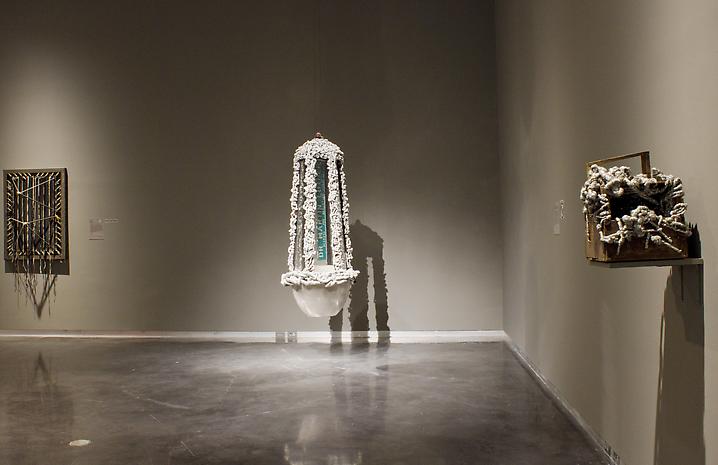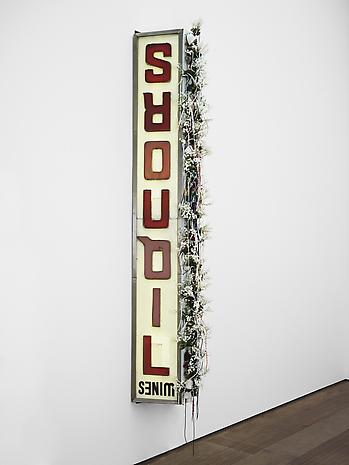
Nari Ward’s ‘Rooted Communities’ in LSU Museum of Art in Baton Rouge, LA
Mow Shine, 2012
aluminet shade cloth, used wooden shoe shine box, mower starter
16 x 19 x 18 inches
40.6 x 48.3 x 45.7 cm
 Rooted Communities
Rooted Communities
Installation view, LSU Museum of Art, Baton Rouge, LA
February 7 – August 10, 2014
Photo by Kim Jones, courtesy LSU Museum of Art
Nari Ward’s Found Artwork
Written by Ruth Laney (in CountryRoadsMagazine)
Rooted Communities
Installation view, LSU Museum of Art, Baton Rouge, LA
February 7 – August 10, 2014
Photo by Kim Jones, courtesy LSU Museum of Art
Nari Ward makes art from what most people see as trash
Nari Ward (1963, Jamaica) can “skin” a TV set in thirty seconds—sometimes less. The artist used the backs of television sets in a piece called ConSoul that also encompasses window locks, a phonograph, felt weather stripping, and several dozen mango seeds spray-painted gold.
“I spent two months collecting TV sets,” said Ward, whose show at the LSU Museum of Art in the Shaw Center opened in February and will run through August. “I carried screwdrivers with me and could skin a TV in thirty seconds. I had my kids time me. Sometimes I had it down to fifteen seconds.
“I’m interested in spaces that people do not look at,” said Ward. “Nobody ever really focuses on the back of a TV.”
Rooted Communities, Ward’s first solo exhibition in Louisiana, comprises twenty-five mixed-media sculptures. Some are free-standing, while others hang from the walls or ceiling. The 2013–14 recipient of the LSU School of Art’s Nadine Carter Russell Chair, Ward has made five trips to Baton Rouge from his home in New York City’s Harlem over the past six months. His first visits were to get to know the city and to meet his students. This past March, he gave a lecture on his work at LSU; and in April, he returned to debut an installation made with students in an advanced-sculpture class. Ward’s final visit will be this month, when he will install an addition to one of his works at the museum.
On an early visit, Ward stumbled across the site of the demolished Alvin Roy gym on Oklahoma Street off Highland Road. In a landfill, he found old bottles that were, remarkably, unbroken. Salvaging about eighty of them, he enlisted students to help him construct Plexiglas “free weights,” inserting a bottle into each one. They hang on the wall of the museum, and an “incubator” holds others that you can reach in and handle.
 Rooted Communities
Rooted Communities
Installation view, LSU Museum of Art, Baton Rouge, LA
February 7 – August 10, 2014
Photo by Kim Jones, courtesy LSU Museum of Art
 Loisaidas LiquorsouL, 2011
Loisaidas LiquorsouL, 2011
metal, plexigalss, fluorescent sign, pvc pipe with artificial flowers, shoelaces and shoe tips
144 x 30 x 24 inches
365.8 x 76.2 x 61 cm
Wanting to tie “Free Weights Incubator” more closely to the Old South Baton Rouge community, Ward met with about eighty former residents and photographed them holding the weights. The photos will go up on the wall of the museum during his final visit this month. The subjects include members of the Delpit family, Rev. Raymond Jetson, and councilwoman Tara Wicker. “The bottles become a metaphor for history,” Ward said. “Knowing one’s history can be strengthening.”
A large piece titled “Homeland Sweet Homeland” has the words “I wish to speak to my attorney now” embroidered in gold thread on fabric. “I have my business cards printed with this on the back,” said Ward. “We need to be more aware of our rights as citizens.”
Although he has lived in the U.S. since he was twelve, Ward only became a citizen in 2010. “It was a powerful experience,” he said of the naturalization ceremony in which about one hundred people took the Oath of Allegiance. “Really moving and powerful. The woman next to me was bawling her eyes out. You get caught up in the beauty of the ceremony.”
Ward now has dual citizenship. Born in St. Andrews, Jamaica, in 1963, the youngest of five, he moved to this country after his mother was hired as a housekeeper. Gradually, the rest of the family joined her.
“It was strange,” recalled Ward of the family’s being split up and reunited. “She was gone at least three years. There is an element of abandonment in it. I wonder if that has to do with my interest in castoffs, my empathy for these things.”
The family lived in Brooklyn for two years and then moved to Parsippany, New Jersey. “It was a middle-class resort town,” Ward recalled. “We were the only African-American family in the neighborhood. There was always that disconnection, a kind of double oddness—being black and Jamaican.”
Ward is friendly and down to earth, with none of the hauteur one might expect of a successful artist. But he said a woman collector had been surprised to learn that he was Jamaican, observing, “You don’t seem very happy.” Although he laughs at the idea of the stereotypical jolly Jamaican, he also sees its connection to the African-American minstrel figure. He claimed to be able to turn the Jamaican patois on and off.
“It’s like another language,” he said. “I can switch into it when I’m around Jamaican friends and family members. My sister has a more refined accent. I have a very country-bumpkin accent, and here I am the university professor.” (He is a full professor at Hunter College.) Ward earned a B.A. from Hunter and an MFA from Brooklyn College. He originally focused on painting and drawing, only turning to sculpture in his last year of graduate school. “I’ve always been a social realist,” he said. “I want to tell stories. I always wanted to talk about what was going on in my neighborhood, my community. I could use materials that became characters in the story.”
Ward won a fellowship to Italy, the 2012–13 Rome Prize, bestowed by the American Academy in Rome. He has also received commissions and awards from the United Nations, the World Health Organization, the American Academy of Arts and Letters, the National Endowment for the Arts, and the Guggenheim Foundation.
He and his wife Noemi and their children—son Zendon and daughter Nira—studied Italian, although Ward said the children learned more than their parents. “Rome was an amazing experience,” he said. “It was life-changing for my family.” He was particularly fascinated by the Arte Povera (“Poor Art”) movement of the sixties and seventies. “They tried to break from tradition and use humble materials,” he said.
Humble materials have intrigued Ward ever since he turned to sculpture, creating assemblages and installations from found objects, the detritus of society.
 Rooted Communities
Rooted Communities
Installation view, LSU Museum of Art, Baton Rouge, LA
February 7 – August 10, 2014
Photo by Kim Jones, courtesy LSU Museum of Art
One of his more ambitious projects, Amazing Grace, featured baby strollers. “I was walking down 125th Street and found an abandoned stroller,” he recalled. “Something about its emptiness and starkness struck me. I figured if I had enough of them, a year’s worth, I could do an installation. Each day I’d go out and collect them. If I found a twin stroller, it was the best day of my life. If I found none, it was the worst day of my life. It took me four months to collect them.”
No gallery was big enough for the installation, so Ward staged it in an abandoned firehouse, tying the strollers together with fire hoses. “The space was long and narrow, and that’s how that shape evolved,” he said. “It looked like a slave ship. That was scary. I had to figure out how to redeem it.
“I thought about the sounds I grew up with, my father playing Mahalia Jackson’s version of ‘Amazing Grace.’ I was interested in the idea of awakening. This piece was later installed in four or five venues and eventually bought by a collector.”
Ward later bought the abandoned firehouse. He uses the first story as his studio, and he and his family live in the top two stories. In the basement he stores material for future works. “Whenever I see that show Hoarders I freak out,” he admitted. “So I have a mandate now. When I bring something in, I have to bring something out. I have my own kind of filing system. I know exactly where things are.”
In 2008, Ward participated in Prospect 1 in New Orleans, which showcased the work of contemporary artists at venues across the city. Ward worked in one of the communities hit hardest by Hurricane Katrina in 2005, the Ninth Ward.
“There was a lot of loss,” he said. “But I wanted to talk about the people who decided to stay. I found an abandoned church, Battle Ground Baptist Church, which had been moved there twenty years earlier from Chalmette. When I saw the inside I said, ‘This is the church I want to work with.’” He created a diamond-shaped sculpture from abandoned gym equipment and added flyers stapled to a community bulletin board.
“I wanted to use the voices of Martin Luther King, Malcolm X, and Marcus Garvey,” said Ward. “We played their speeches on speakers. Then I decided I needed a female voice, so I added Tina Turner doing a Buddhist chant.”
At his talk last March, Ward played a tape of the sound that accompanied the sculpture—a haunting mélange of voices in which you can just make out a few words here and there. “I wanted you to come out and feel charged up,” he said. “Like you could do cartwheels in the street.” Now back in New York, his antennae are always out for the next found object, which may spend years stored in his basement until he finds the perfect use for it.
“I’m always looking to see what other people don’t seem to look at any more,” he said. “The whole street culture—anything can happen in that space.”
He isn’t always sure what he’s looking for. “You just know it when you see it,” he said. “It has to talk to me.”
Ruth Laney can be reached at ruthlaney@cox.net.

